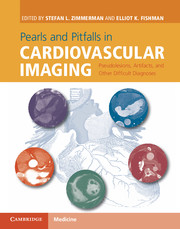 Pearls and Pitfalls in Cardiovascular Imaging
Pearls and Pitfalls in Cardiovascular Imaging from Section 3 - Anatomic variants and congenital lesions
Published online by Cambridge University Press: 05 June 2015
Imaging description
A tubular connection between the proximal descending aorta and the main pulmonary artery which opacifies after intravenous contrast administration (Figure 25.1) most likely represents a patent ductus arteriosus (PDA). The luminal diameter of the PDA is typically larger at the aortic end than at the pulmonic end (Figure 25.2). Cine imaging can be used to confirm that there is flow through the vessel from the aorta to the pulmonary artery, rather than just a pseudoaneurysm of the aorta that abuts the main pulmonary artery. Sagittal oblique MR images through the aorta demonstrate the PDA and confirm its patency by capturing the flow jet (dark signal) caused by flow into the main pulmonary artery (Figure 25.3).
Importance
The significance of a patent ductus arteriosus detected on imaging depends on its effect on the patient. Evaluation of the functional significance of a PDA is ideally performed with a cardiac MRI that can quantify not only cardiac ejection fraction but also shunt fraction and direction. An incidentally discovered PDA may not need further imaging evaluation in an asymptomatic individual.
Typical clinical scenario
The ductus arteriosus (DA) is an embryological connection between the proximal descending aorta and the main pulmonary artery (MPA). It exists to shunt deoxygenated blood away from the pulmonic circulation (which is high resistance in utero) back into the aorta so that it can travel to the placenta for oxygenation. The incidence of patent ductus arteriosus is low in term infants (57 per 100,000 live births) but can be very high in preterm infants (1 in 3 live births).
Normally the DA closes within 24–48 hours of birth, although it can be kept open pharmacologically with the administration of prostaglandins, particularly in the case of congenital heart disease where a left-to-right shunt is necessary to survive until surgery (Figure 25.4). When it closes normally, the DA becomes the ligamentum arteriosum, a fibrous connection between the two great vessels without any lumen.
To save this book to your Kindle, first ensure no-reply@cambridge.org is added to your Approved Personal Document E-mail List under your Personal Document Settings on the Manage Your Content and Devices page of your Amazon account. Then enter the ‘name’ part of your Kindle email address below. Find out more about saving to your Kindle.
Note you can select to save to either the @free.kindle.com or @kindle.com variations. ‘@free.kindle.com’ emails are free but can only be saved to your device when it is connected to wi-fi. ‘@kindle.com’ emails can be delivered even when you are not connected to wi-fi, but note that service fees apply.
Find out more about the Kindle Personal Document Service.
To save content items to your account, please confirm that you agree to abide by our usage policies. If this is the first time you use this feature, you will be asked to authorise Cambridge Core to connect with your account. Find out more about saving content to Dropbox.
To save content items to your account, please confirm that you agree to abide by our usage policies. If this is the first time you use this feature, you will be asked to authorise Cambridge Core to connect with your account. Find out more about saving content to Google Drive.